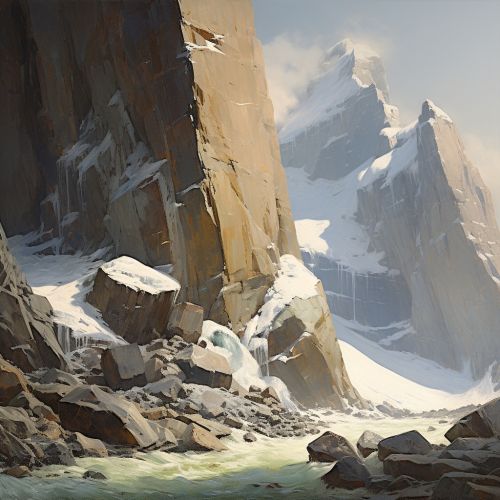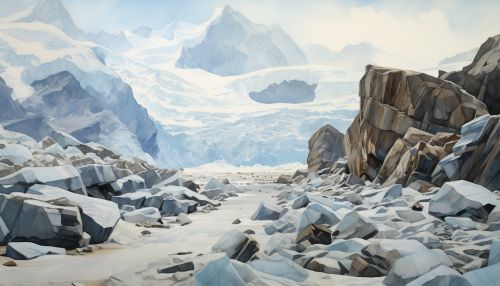Glacial plucking
Introduction
Glacial plucking is a glacial erosion process where a glacier freezes onto the bedrock, then as it moves, it plucks or lifts a block of rock out of the bedrock. This process is facilitated by the freezing of water in cracks in the rock, which expands and causes the rock to break apart, a process known as frost weathering. The plucked rocks then become part of the glacier's load and can be transported great distances.


Process of Glacial Plucking
The process of glacial plucking involves several stages. Firstly, the glacier must be moving over a bedrock surface that has pre-existing cracks or fissures. These cracks may be formed through various processes, including tectonic activity, physical weathering, and chemical weathering.
When the glacier moves over the bedrock, it causes pressure on the rock surface. This pressure causes the ice at the base of the glacier to melt, creating a thin layer of water. This water can infiltrate the cracks in the rock. When the pressure is released, the water refreezes, expanding in the process. This expansion exerts a force on the surrounding rock, causing it to fracture and break apart.
The fractured rock is then incorporated into the base of the glacier through a process known as entrainment. The rock becomes part of the glacier's load and is transported downstream with the movement of the glacier. This process is known as glacial transport.
Factors Influencing Glacial Plucking
Several factors influence the rate and effectiveness of glacial plucking. These include the temperature of the glacier, the speed of glacial movement, the nature of the bedrock, and the presence of water.
Temperature
The temperature of the glacier plays a crucial role in glacial plucking. Glaciers that are at or near the melting point (0°C) are more effective at plucking than those that are colder. This is because warmer glaciers have more liquid water available to infiltrate cracks in the bedrock and facilitate the freeze-thaw cycle.
Speed of Glacial Movement
The speed at which a glacier moves can also influence the rate of plucking. Faster moving glaciers have a higher erosive power and can pluck more material from the bedrock. However, if a glacier moves too quickly, it may not have enough time to freeze onto the bedrock and pluck material effectively.
Nature of the Bedrock
The nature of the bedrock is another important factor. Rocks that are more susceptible to physical weathering, such as those with a high content of feldspar or other minerals that expand when frozen, are more likely to be plucked by a glacier. Additionally, bedrock with more cracks and fissures provides more opportunities for water to infiltrate and freeze, facilitating the plucking process.
Presence of Water
The presence of water is crucial for glacial plucking. Without water, the freeze-thaw cycle cannot occur, and plucking is less effective. Therefore, glaciers that are located in areas with high precipitation or meltwater production are more likely to exhibit significant plucking.
Impacts of Glacial Plucking
Glacial plucking has several significant impacts on the landscape. These include the creation of distinctive landforms, the alteration of river systems, and the deposition of sediment.
Creation of Distinctive Landforms
One of the most visible impacts of glacial plucking is the creation of distinctive landforms. These include cirques, aretes, and roches moutonnées. Cirques are bowl-shaped depressions carved into the side of a mountain by glacial plucking and abrasion. Aretes are sharp ridges formed when two cirques erode towards each other. Roches moutonnées are elongated hills with a gentle slope on one side and a steep, often plucked, slope on the other.
Alteration of River Systems
Glacial plucking can also significantly alter river systems. The plucked material is transported by the glacier and eventually deposited downstream. This deposition can change the course of rivers, create new lakes, and influence the distribution of sediment in a river system.
Deposition of Sediment
The sediment plucked and transported by a glacier is eventually deposited when the glacier melts. This process, known as glacial deposition, can create a range of landforms, including moraines, drumlins, and eskers. These features provide important evidence of past glacial activity and can be used to reconstruct the history of a glacier.
